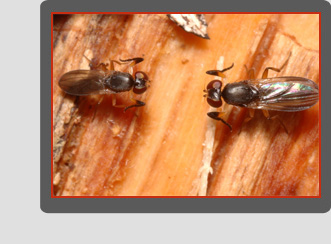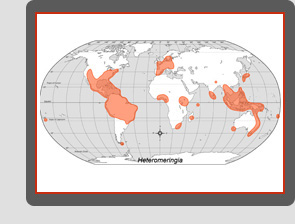| |

Characteristics
Heteromeringia is a genus of often darkly pigmented Clusiodinae ranging from 2.4-5.0 mm in length. New World Heteromeringia resemble Sobarocephala species in having an inclinate anterior fronto-orbital bristle but, unlike Sobarocephala, Heteromeringia species lack a dorsal preapical tibial bristle. Heteromeringia species are further distinguished from Sobarocephala by the presence of a pair of small lateral scutellar bristles, an elongate double-ribbed phallus that is often strongly coiled and protruding from the abdomen, and a sometimes elongate and laterally flattened fore tarsus.
Heteromeringia also shares the following clusiodine synapomorphies: the antenna arises at or below the midpoint of the head; the outer extension on the pedicel is blunt and obtuse and the inner extension is absent; the scutellum is flat and wrinkled dorsally, the hypandrial complex has undergone a large amount of reduction and fusion; the spermathecae are longitudinally segmented and are very often dark and telescoped.
Relationships & Distribution
Heteromeringia Czerny is a worldwide genus of 62 species of which only a few occur in the Holarctic: four species (two of which are mostly Neotropical but range north to Florida) are found in the Nearctic and only the type species H. nigrimana Czerny is found in the Palaearctic outside of Japan (Lonsdale & Marshall, 2007a). The genus reaches its greatest diversity in the Oriental Region, but dozens of species are also found in the Australian, Afrotropical and Neotropical Regions.
Sasakawa (1966) revised the Oriental and Pacific Heteromeringia, describing 23 new species and erecting the genus Tranomeringia, now treated as a junior synonym of Heteromeringia (Lonsdale & Marshall, 2008b). Sasakawa provided a key to all Oriental species, genitalic illustrations for all new species, and a phylogeny outlining ten species groups. Lonsdale & Marshall (2007a) revised the New World Heteromeringia, describing numerous new species and two species groups: the H. czernyi group, which is endemic to the Neotropics and diagnosed by two pairs of vibrissae (in part), and the H. nitida group, which is worldwide in distribution and defined by a pilose disc on the male anepisternum.
Biology
New World Heteromeringia (primarily those collected in the Neotropics) have been found to aggregate around relatively open areas such as tree falls, forest borders, pastures and landslides (Lonsdale & Marshall, 2007a). McAlpine (1960) also notes that while most Australian clusiids occur along creeks in rainforests, species of Heteromeringia have been collected in more open forests. In Europe, Heteromeringia nigrimana is associated with dead wood in deciduous or mixed forests, predominantly on fallen decaying tree trunks (Roháček, 1995).
As in other clusiids, oviposition likely occurs in decomposing wood. Australian specimens of Heteromeringia norrisi McAlpine have been bred from rotting wood, and one female was collected "in [a] log with termites" (McAlpine 1960). Heteromeringia have been collected using dung baits and dung traps, mushroom traps and carrion (Lonsdale & Marshall, 2007). Specimens also turn up regularly in Malaise trap samples.
As in other clusiodine genera, males of Heteromeringia engage in agonistic behaviour at probable lek sites, and males of H. nitida have been repeatedly observed defending territory from conspecifics (Lonsdale & Marshall, 2007a). When two males encounter one another on a contested territory, they fold their fore legs backwards to "box" with their contrastingly black elbows (Marshall, 2006). "Scorpion-like" abdominal flexion displays have also been observed in some species, including the Australian H. spinulosa McAlpine (Marshall, unpublished observations).
North American species:
- Heteromeringia czernyi
- Heteromeringia flavipes
- Heteromeringia nigripes
- Heteromeringia nitida
|
|
 |